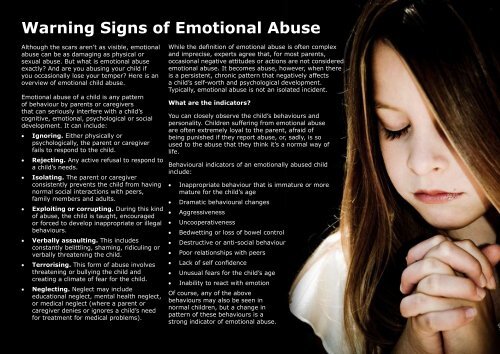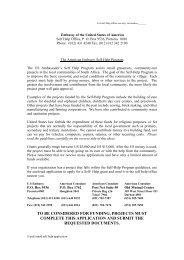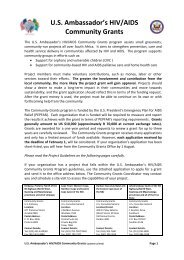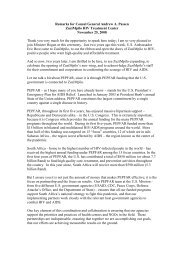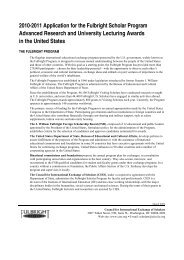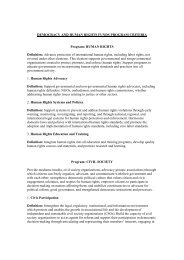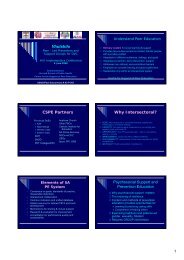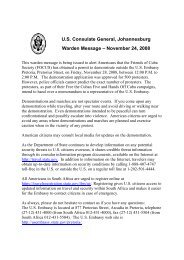Warning signs of emotional abuse (pdf) - South Africa
Warning signs of emotional abuse (pdf) - South Africa
Warning signs of emotional abuse (pdf) - South Africa
You also want an ePaper? Increase the reach of your titles
YUMPU automatically turns print PDFs into web optimized ePapers that Google loves.
<strong>Warning</strong> Signs <strong>of</strong> Emotional Abuse<br />
Although the scars aren’t as visible, <strong>emotional</strong><br />
<strong>abuse</strong> can be as damaging as physical or<br />
sexual <strong>abuse</strong>. But what is <strong>emotional</strong> <strong>abuse</strong><br />
exactly And are you abusing your child if<br />
you occasionally lose your temper Here is an<br />
overview <strong>of</strong> <strong>emotional</strong> child <strong>abuse</strong>.<br />
Emotional <strong>abuse</strong> <strong>of</strong> a child is any pattern<br />
<strong>of</strong> behaviour by parents or caregivers<br />
that can seriously interfere with a child’s<br />
cognitive, <strong>emotional</strong>, psychological or social<br />
development. It can include:<br />
• Ignoring. Either physically or<br />
psychologically, the parent or caregiver<br />
fails to respond to the child.<br />
• Rejecting. Any active refusal to respond to<br />
a child’s needs.<br />
• Isolating. The parent or caregiver<br />
consistently prevents the child from having<br />
normal social interactions with peers,<br />
family members and adults.<br />
• Exploiting or corrupting. During this kind<br />
<strong>of</strong> <strong>abuse</strong>, the child is taught, encouraged<br />
or forced to develop inappropriate or illegal<br />
behaviours.<br />
• Verbally assaulting. This includes<br />
constantly belittling, shaming, ridiculing or<br />
verbally threatening the child.<br />
• Terrorising. This form <strong>of</strong> <strong>abuse</strong> involves<br />
threatening or bullying the child and<br />
creating a climate <strong>of</strong> fear for the child.<br />
• Neglecting. Neglect may include<br />
educational neglect, mental health neglect,<br />
or medical neglect (where a parent or<br />
caregiver denies or ignores a child’s need<br />
for treatment for medical problems).<br />
While the definition <strong>of</strong> <strong>emotional</strong> <strong>abuse</strong> is <strong>of</strong>ten complex<br />
and imprecise, experts agree that, for most parents,<br />
occasional negative attitudes or actions are not considered<br />
<strong>emotional</strong> <strong>abuse</strong>. It becomes <strong>abuse</strong>, however, when there<br />
is a persistent, chronic pattern that negatively affects<br />
a child’s self-worth and psychological development.<br />
Typically, <strong>emotional</strong> <strong>abuse</strong> is not an isolated incident.<br />
What are the indicators<br />
You can closely observe the child’s behaviours and<br />
personality. Children suffering from <strong>emotional</strong> <strong>abuse</strong><br />
are <strong>of</strong>ten extremely loyal to the parent, afraid <strong>of</strong><br />
being punished if they report <strong>abuse</strong>, or, sadly, is so<br />
used to the <strong>abuse</strong> that they think it’s a normal way <strong>of</strong><br />
life.<br />
Behavioural indicators <strong>of</strong> an <strong>emotional</strong>ly <strong>abuse</strong>d child<br />
include:<br />
• Inappropriate behaviour that is immature or more<br />
mature for the child’s age<br />
• Dramatic behavioural changes<br />
• Aggressiveness<br />
• Uncooperativeness<br />
• Bedwetting or loss <strong>of</strong> bowel control<br />
• Destructive or anti-social behaviour<br />
• Poor relationships with peers<br />
• Lack <strong>of</strong> self confidence<br />
• Unusual fears for the child’s age<br />
• Inability to react with emotion<br />
Of course, any <strong>of</strong> the above<br />
behaviours may also be seen in<br />
normal children, but a change in<br />
pattern <strong>of</strong> these behaviours is a<br />
strong indicator <strong>of</strong> <strong>emotional</strong> <strong>abuse</strong>.
Common characteristics <strong>of</strong> the abusing adult<br />
include:<br />
• Blaming or belittling the child in public<br />
• Describing the child negatively<br />
• Always assuming the child is at fault<br />
• Having unrealistic expectations <strong>of</strong> the child<br />
• Openly admitting to disliking or hating the<br />
child<br />
• Threatening the child with severe punishment<br />
• Withdrawing comfort as a means <strong>of</strong> discipline<br />
• Being <strong>emotional</strong>ly cold and unsupportive<br />
• Suffering from alcohol and drug <strong>abuse</strong><br />
• Having a violent nature<br />
What are the effects <strong>of</strong> <strong>emotional</strong> <strong>abuse</strong><br />
Like other types <strong>of</strong> <strong>abuse</strong>, the consequences<br />
<strong>of</strong> <strong>emotional</strong> child <strong>abuse</strong> can be serious and<br />
long-term. Many research studies conclude that<br />
psychopathologic symptoms are more likely to<br />
develop in <strong>emotional</strong>ly <strong>abuse</strong>d children. These<br />
children may experience a lifelong pattern <strong>of</strong><br />
depression, estrangement, anxiety, low selfesteem,<br />
inappropriate or troubled relationships,<br />
or a lack <strong>of</strong> empathy.<br />
During their childhood, <strong>emotional</strong>ly <strong>abuse</strong>d<br />
children may fail to thrive or their developmental<br />
progress may be halted. Some may also<br />
become poorly adjusted <strong>emotional</strong>ly and<br />
psychologically. As teenagers, they find it difficult<br />
to trust, participate in and achieve happiness<br />
in interpersonal relationships, and resolve the<br />
complex feelings left over from their childhoods.<br />
As adults, they may have trouble recognising and<br />
appreciating the needs and feelings <strong>of</strong> their own<br />
children and <strong>emotional</strong>ly <strong>abuse</strong> them as well.<br />
What you can do<br />
If you are worried that a child you know<br />
is suffering <strong>emotional</strong> <strong>abuse</strong>, it is your<br />
responsibility to report it to authorities.<br />
If you feel your behaviour toward your own<br />
child is bordering on <strong>emotional</strong> <strong>abuse</strong>, here is<br />
what you should do:<br />
• Never be afraid to apologise to your<br />
child. Children need to know that adults<br />
can admit when they are wrong.<br />
• Don’t call your child names or attach<br />
labels to your child. Names such as<br />
“Stupid” or “Lazy” erodes a child’s selfesteem.<br />
A child deserves respect.<br />
• Address the behaviour that needs<br />
correcting and use appropriate<br />
discipline techniques, such as time outs<br />
or natural consequences. Be sure to discuss<br />
the child’s behaviour and the reason for<br />
the discipline, both before and immediately<br />
after you discipline.<br />
• Compliment your child when he or she<br />
accomplishes even a small task.<br />
• Walk away from a situation when<br />
you feel you are losing control. Isolate<br />
yourself in another room for a few minutes<br />
(after first making sure the child is safe),<br />
count to 10 before you say anything, ask<br />
for help from another adult or take a few<br />
deep breaths before reacting.<br />
• Get help. Support is available for families<br />
at risk <strong>of</strong> <strong>emotional</strong> <strong>abuse</strong> through local<br />
child protection services agencies, doctors,<br />
mental health facilities and schools.<br />
All children need acceptance, love,<br />
encouragement, discipline,<br />
consistency, stability and<br />
positive attention. Do what<br />
you can to ensure the children<br />
you know get what they<br />
deserve.<br />
Copyright HealthInSite - www.healthinsite.net


